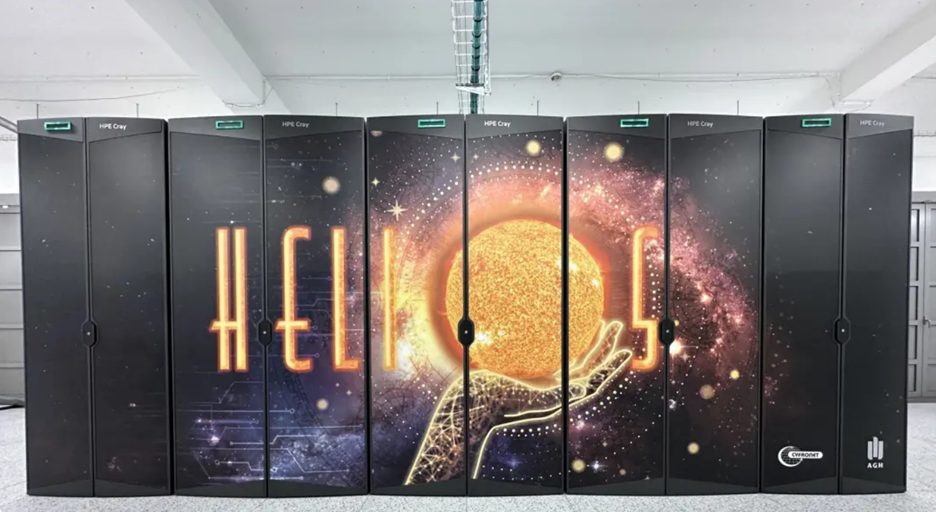Hewlett Packard Enterprise unveiled Helios, Poland’s fastest supercomputer, for the Academic Computer Centre Cyfronet at AGH University of Krakow. Helios, based on the HPE Cray EX system, features three partitions: one for traditional scientific research, another with Nvidia GPUs for AI applications, and a third for big data processing. Powered by 4th-gen AMD Epyc CPUs and Nvidia Grace Superchips, Helios supports diverse research fields like computational fluid dynamics, drug discovery, and AI training. It’s poised to advance AI-driven scientific studies in astronomy, medicine, and climate protection with improved performance and energy efficiency.

Hewlett Packard Enterprise (HPE) announced that it has built a new supercomputer for the Academic Computer Centre (ACC) Cyfronet of the AGH University of Krakow, making it Poland’s fastest system. The new system, called Helios, is Cyfronet’s fifth-generation supercomputer and will be used to advance AI-driven scientific research in astronomy, medicine, and climate protection, as well as innovative commercial applications, with higher performance and greater energy efficiency.
The Helios system is based on the HPE Cray EX supercomputer and features three partitions: the first dedicated to traditional computational scientific research; the second purpose-built with Nvidia GPUs to support AI applications and AI-driven research; and the third to support interactive workloads that involve big-data processing.
HPE’s announcement was not the only one pertaining to Helios.
AMD also announced AGH University of Krakow unveiled a new supercomputer, powered by 4th-gen AMD Epyc CPUs, called Helios, which will be Poland’s fastest system to date.
And, Nvidia announced that the Grace Superchip would be part of the Helios at Academic Computer Centre Cyfronet, in Poland, from Hewlett Packard Enterprise (HPE).
So, it looks like Helios is a big (Epyc)–little (Arm) design.
The HPE Cray Supercomputing EX CPU partition is equipped with 75,264 Zen 4 cores from 4th-gen AMD Epyc processors and 200TB of DDR5 memory. This partition is targeted at modeling and simulation workloads, such as computational fluid dynamics used for wind turbines and propellers, car crash simulation tests, and medicine, such as beam simulations in proton therapy used in cancer treatment, among others.
HPE Cray Supercomputing EX with GPU partition, equipped with 440 Nvidia GH200 Grace Hopper Superchips, is targeted for image-intensive computer simulations in materials engineering, solid-state physics, drug discovery, and large-scale AI training, such as generative AI.
HPE Cray Supercomputing XD665 with INT partition—targeted for interactive work with big data, tuning AI models, and running applications that use AI for inference—is equipped with 24 Nvidia H100 Tensor Core GPUs and high-speed NVMe local storage.
All components of the supercomputer are interconnected with HPE Slingshot, which provides 200 Gbps of purpose-built, high-performance networking to address demands for higher speed and congestion control of data-intensive workloads. Based on HPE Cray technology, this tunable interconnection supercharges performance for the entire system by enabling extremely high-speed networking. Helios also has a total of..5PB of Lustre file system storage built on the HPE Cray ClusterStor E1000 storage system.
Helios at a glance:
- 35 PFLOPS of computing power
- Built on the HPE Cray EX4000 platform
- 75,264 AMD Zen 4 computing cores
- 440 Nvidia Grace Hopper GH200 Superchips
- 24 Nvidia H100 accelerators
- 17.5PB disc subsystem
- Slingshot 200 Gbps internal network
- World level of energy efficiency
- Helios GPU, highest TOP500 rank: 55 (year 2024)
- Helios GPU, highest Green500 rank: 3 (year 2024)
- Helios CPU, highest TOP500 rank: 290 (year 2023)
- Helios CPU, highest Green500 rank: 343 (year 2023)
The ACC Cyfronet AGH was established in 1973 to operate and expand high-performance computers and the Krakow Metropolitan Area Network (MAN). Cyfronet is the leader of the PL-Grid Consortium, consolidating national computing resources for science and providing many unique IT support services, as well as the leader of the Polish National Competence Centre in HPC, which serves as a contact and access point for both academia and industry. Cyfronet participates in developing many Polish and European R&D initiatives, including EGI, EOSC, EPOS, EuroHPC, LUMI, LUMI-Q, and Digital Twins in Earth and Health Sciences. For more information, visit the Cyfronet website.